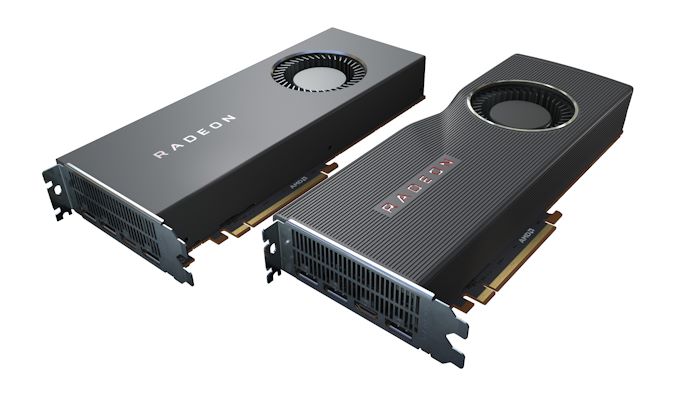
There have been teasers, press conferences, architectural announcements, and pricing games all around – and all before the first card has even shipped. The run-up to the launch of AMD’s new Radeon RX 5700 series of video cards has been a dynamic and memorable time, and a very fitting outcome for a family of cards named after AMD’s legendary Radeon HD 5700 series. However, at some point all the showmanship must come to an end and the cards will fall where they may: launch day is upon us for AMD’s Radeon RX 5700 series and RDNA GPU architecture.
I’m not sure there’s anything traditional about an AMD video card launch at this point, but today’s launch is about as non-traditional as they come, right on down to the Sunday launch date. AMD announced their video cards almost a month ago at an epic (ed: that’s EPYC) E3 event, taking the wraps off of both their new CPUs and GPUs. Rather than hold anything back, AMD came to E3 with everything front-loaded: specifications, prices, architectural details; everything except a pile of cards to sell. So we’ve been waiting for this moment for some time now, to test AMD’s claims about power, performance, and features, and see how they translate into real-world gaming performance. AMD has a lot that they want to do in the video card space, and riding high on their success with Zen the company’s ambition is once again palpable.
Getting down to business then, today is the launch of AMD’s next generation of video cards, the Radeon RX 5700 series. Aimed at what these days is the midrange segment of the video card market, AMD is looking to carve out a new place for the company in the hearts of gamers who are looking for high performance video cards that won’t break the bank. These parts are, in turn, based on AMD’s Navi 10 GPU, which is the first GPU using the company’s new RDNA architecture. And, while Navi 10 is not AMD’s first 7nm GPU – an honor the Radeon VII and its Vega 20 beat it to – it’s the first 7nm GPU that you’re actually going to want to pay attention to.
Altogether, AMD is rolling out two(ish) cards today. At $399 we have AMD’s new class-leading Radeon RX 5700 XT, which is a full-fledged Navi 10 card with all the trimmings. Meanwhile, for the slightly more budget conscious, we have the $349 Radeon RX 5700 (vanilla), a cut-down Navi 10 card that gives up some performance for lower pricing and lower power consumption. Finally, AMD is also launching their own “Anniversary Edition” version of the 5700 XT, which features a factory overclock and will sell for $449. (This card will be a footnote for today’s article, as it’s a limited-edition card that AMD isn’t sampling)
| AMD Radeon RX Series Specification Comparison | ||||||
| AMD Radeon RX 5700 XT | AMD Radeon RX 5700 | AMD Radeon RX 590 | AMD Radeon RX 570 | |||
| Stream Processors | 2560 (40 CUs) |
2304 (36 CUs) |
2304 (36 CUs) |
2048 (32 CUs) |
||
| Texture Units | 160 | 144 | 144 | 128 | ||
| ROPs | 64 | 64 | 32 | 32 | ||
| Base Clock | 1605MHz | 1465MHz | 1469MHz | 1168MHz | ||
| Game Clock | 1755MHz | 1625MHz | N/A | N/A | ||
| Boost Clock | 1905MHz | 1725MHz | 1545MHz | 1244MHz | ||
| Throughput (FP32) | 9.75 TFLOPs | 7.95 TFLOPs | 7.1 TFLOPs | 5.1 TFLOPs | ||
| Memory Clock | 14 Gbps GDDR6 | 14 Gbps GDDR6 | 8 Gbps GDDR5 | 7 Gbps GDDR5 | ||
| Memory Bus Width | 256-bit | 256-bit | 256-bit | 256-bit | ||
| VRAM | 8GB | 8GB | 8GB | 4GB | ||
| Transistor Count | 10.3B | 10.3B | 5.7B | 5.7B | ||
| Typical Board Power | 225W | 180W | 225W | 150W | ||
| Manufacturing Process | TSMC 7nm | TSMC 7nm | GloFo/Samsung 12nm | GloFo 14nm | ||
| Architecture | RDNA (1) | RDNA (1) | GCN 4 | GCN 4 | ||
| GPU | Navi 10 | Navi 10 | Polaris 30 | Polaris 10 | ||
| Launch Date | 07/07/2019 | 07/07/2019 | 11/15/2018 | 08/04/2016 | ||
| Launch Price | $399 | $349 | $279 | $179 | ||
For both gamers and AMD, the launch of the RX 5700 is an important one – and likely to be the most significant video card launch of the year. For consumers, this is the first series of high-volume video cards built on a 7nm process, pushing performance up and prices down at a time where video card pricing has been sluggish improve. For AMD, this launch gets their incredibly important RDNA architecture out the door to its first users, all the while renewing their competitiveness in the midrange market. The RX 5700 series aren’t flagship-level cards, but make no mistake: for AMD they’re still as important as any flagship launch.
AMD’s Radeon DNA (RDNA) architecture, in turn, is an interesting development. We’ll get into much greater detail later on, but at a high level RDNA is the most significant architectural development for AMD since the launch of Graphics Core Next in 2011. AMD and its engineers have made changes to their GPU architecture at some of its most fundamental levels, which comes with significant ramifications for performance, efficiency, and more. This is all to prepare their next-generation architecture for the company’s grand goals: RDNA and its successors will be in PC video cards, in APUs, in game consoles, and thanks to a partnership with Samsung, even in mobile GPUs.
Still, RDNA is only as valuable as the performance it brings, and this will especially be the case for the RX 5700 series. The first iteration of this architecture is all about changing the internal plumbing of AMD’s GPUs. As a result, there are no real marquee hardware features to speak of – AMD isn’t rolling out paradigm-changing features like ray tracing or the next Rapid Packed Math – so for consumers, the RX 5700 cards are essentially interchangeable with 2017’s Vega cards in terms of graphics functionality. Which is not to say that AMD is showing up empty-handed, but what new features it is rolling out – Radeon Anti-Lag and Radeon Image Sharpening – are software-based features that will be available to the entire Radeon product family. This means that the payoff for AMD needs to be in pricing, power consumption, and performance; the RX 5700 needs to deliver on the fundamentals.
Ultimately there are a lot of words I could spill on the subject of AMD, especially on today of all days, the launch of both their next-generation CPU and GPU architectures. But perhaps it’s best to keep things simple: today’s launch of the company’s Radeon RX 5700 series video cards and the RDNA architecture is a much-needed opportunity for the company to reset and recover in the video card space. Vega was ultimately underwhelming, Polaris is very long in the tooth, and AMD is still feeling the hangover from the cryptocurrency boom & busts. The company has held on to their consumer market share through aggressive pricing – RX 500 series cards are disruptively cheap – but AMD needs to be more visible and more profitable if they want to remain a viable competitor to juggernaut NVIDIA. Not to mention shoring up their position as Intel ramps up to become the third player in the video card space in the next couple of years.
Product Positioning, Availability & the Competition
Leading up to today’s launch, the announcement Radeon RX 5700 series has created quite a butterfly effect across the greater video card industry. With AMD having shown their cards early, NVIDIA, who has essentially been dominating the $300+ space since the start of the year, made their own preemptive move with the launch of the GeForce RTX 2070 Super and the RTX 2060 Super. A price cut in everything but name, the new Super cards saw NVIDIA essentially shift the performance of its $699 RTX 2080 and $499 RTX 2070 cards down to $499 and $399 respectively. These cards won’t go on sale for another two days (on a more traditional Tuesday), but it’s a launch that was clearly intended to shore up NVIDIA’s own position while taking some steam out of AMD’s launch.
AMD in turn made their own adjustments, cutting the price of their cards on Friday before they even launched. While the RX 5700 XT was originally set to launch at $449 and the RX 5700 (vanilla) at $379, these became $399 and $349 cards respectively before the first board was ever sold. These kinds of last-minute pricing shenanigans are not unheard of – first impressions count for a lot – however it’s been a long time since we’ve seen AMD and NVIDIA trading shots in quite such a direct manner. The net result is that, at least for the $349 to $499 segment of the video card market, the performance-per-dollar ratio just went up even more.
Overall, outside of today’s unusual launch date, this should be a pretty standard launch cycle for AMD. The company is launching with reference cards first, meaning that AMD and board partners alike will be selling cards based on AMD’s reference PCB and blower. Custom and semi-custom cards will come later, as supplies ramp up, board partners qualify their coolers, and new, GDDR6-capable PCBs are engineered. AMD has not disclosed how many cards are being distributed for the launch, but these days it’s rare to see a new generation of midrange (or better) cards not sell out at launch. So anyone interested in an RX 5700 card may need to act quickly.
Within AMD’s product stack, these new cards will be the backbone of AMD’s product lineup. The company’s Vega family of cards was already on its way out due to competition from NVIDIA, so this will be the final push for those cards. That will leave the Radeon VII above the RX 5700 cards, and then the RX 500 series below it. And while AMD hasn’t announced any other Navi GPUs, sooner or later those cards will get pushed out too by a lower-tier Navi GPU.
Trickier, perhaps, is placing the new cards within a historical context for AMD’s product lineups. Is the Radeon RX 5700 series the successor to the RX Vega series, or the RX 500 series? In terms of pricing and absolute performance, it’s closer to the former. However in terms of die size and relative performance gains, these cards feel a lot like the next-generation successors to Polaris. It’s a bit of an academic question – buyers are going to focus on perf-per-dollar first and foremost – but how these cards are framed will have an impact on how they’re received.
Sizing up the competition, AMD was originally going to launch these cards against NVIDIA’s GeForce RTX 2070 and RTX 2060. Now with the launch of the Super cards and the impending retirement of the RTX 2070, those matchups have changed. NVIDIA’s competition is now the RTX 2060 Super at $399, and the RTX 2060 (vanilla) at $349, both prices directly opposite AMD’s new cards. AMD in turn comes in with the edge on manufacturing process, as they’re using TSMC 7nm versus the 16nm offshoot that NVIDIA uses, however NVIDIA comes in with a notable feature advantage thanks to ray tracing and variable rate shading support. AMD and NVIDIA’s cards are not equal in features, and that will play a big part in their value.
Ultimately, today’s launch isn’t a case of a next-generation card coming in and wiping the floor with its last-generation competition; like the RTX 20 series launch last year, the RX 5700 launch is a more gradual shift in pricing and performance. GPU development is expensive, 7nm is even more expensive, and everyone is playing things a lot more conservatively than they did earlier this decade. For the moment then, the RX 5700 series can largely be considered to be part of the same generation of GPUs as the RTX 20/GTX 16 series, for all of the benefits and downsides that entails. The upside is that we get more to talk about, and get to form a more nuanced opinion, but for anyone looking for a simple recommendation for a new video card, there won’t be anything quite that simple with this launch.
Finally, both AMD and NVIDIA will be looking to tip the scales with game bundles. On the AMD side, the company is launching both its new CPUs and GPUs with their new Xbox Game Pass for PC bundle, which will see the products come with a 3-month voucher for Microsoft’s new game subscription service. Meanwhile NVIDIA is bundling Wolfenstein: Youngblood with its RTX 2060, while the new RTX 2060 Super and RTX 2070 Super cards get that plus Control as well.
| July 2019 GPU Pricing Comparison | |||||
| AMD | Price | NVIDIA | |||
| $1249 | GeForce RTX 2080 Ti | ||||
| Radeon VII | $699 | GeForce RTX 2080 Super | |||
| $499 | GeForce RTX 2070 Super | ||||
| Radeon RX 5700 XT | $399 | GeForce RTX 2060 Super | |||
| Radeon RX 5700 | $349 | GeForce RTX 2060 | |||
The true stars of today's launch are, of course, the new Radeon cards themselves. For today’s launch AMD is going completely reference, and that goes for their partners as well. So what you’ll see here is what you’ll get, in terms of features, design, and performance.
With the launch of a new GPU architecture also comes the launch of new drivers, and the teething issues that come with those. We’ll go over performance matters in greater detail on the following pages, but to start things off, I wanted to note the state of AMD’s driver stack, and any notable issues I ran into.
The big issue at the moment is that while AMD’s drivers are in fairly good shape for gaming, the same cannot be said for compute. Most of our compute benchmarks either failed to have their OpenCL kernels compile, triggered a Windows Timeout Detection and Recovery (TDR), or would just crash. As a result, only three of our regular benchmarks were executable here, with Folding@Home, parts of CompuBench, and Blender all getting whammied.
And "executable" is the choice word here, because even though benchmarks like LuxMark would run, the scores the RX 5700 cards generated were nary better than the Radeon RX 580. This a part that they can easily beat on raw FLOPs, let alone efficiency. So even when it runs, the state of AMD's OpenCL drivers is at a point where these drivers are likely not indicative of anything about Navi or the RDNA architecture; only that AMD has a lot of work left to go with their compiler.
So while I’m hoping to better dig into the compute implications of AMD’s new GPU architecture at a later time, for today’s launch there’s not going to be a lot to say on the subject. Most of our usual (and most informative) tools just don’t work right now.
As for the gaming side of matters, things are a lot better. Compared to some past launches, I’ve encountered a surprisingly small amount of “weirdness” with AMD’s new hardware/drivers on current games. Everything ran, and no games crashed due to GPU issues (outright bugs, on the other hand…).
The only game I’d specifically flag here is Assassin’s Creed Odyssey, a DirectX 11 game. With an unlocked framerate, this is not a benchmark that runs incredibly smoothly to begin with; and the RX 5700 series cards seemed to fare a bit worse here. The amount of (additional) stuttering was easy enough to pick up with my eyes, and the game’s own reporting tools recorded it as well. It is not a night and day difference since the game doesn’t start from a great place, but it’s clear that AMD has some room to tighten up its drivers as far as frame delivery goes.
Finally, for whatever reason, the RX 5700 cards wouldn’t display the boot/BIOS screens when hooked up to my testbed monitor over HDMI. This problem did not occur with DisplayPort, which is admittedly the preferred connection anyhow. But it’s an odd development, since this behavior doesn’t occur with Vega or Polaris cards – or any other cards I’ve tested, for that matter.
Meanwhile, as a reminder, here is the list of games for our 2019 GPU benchmarking suite.
| AnandTech GPU Bench 2019 Game List | ||||
| Game | Genre | Release Date | API | |
| Shadow of the Tomb Raider | Action/TPS | Sept. 2018 | DX12 | |
| F1 2019 | Racing | Jun. 2019 | DX12 | |
| Assassin's Creed Odyssey | Action/Open World | Oct. 2018 | DX11 | |
| Metro Exodus | FPS | Feb. 2019 | DX12 | |
| Strange Brigade | TPS | Aug. 2018 | Vulkan | |
| Total War: Three Kingdoms | TBS | May. 2019 | DX11 | |
| The Division 2 | FPS | Mar. 2019 | DX12 | |
| Grand Theft Auto V | Action/Open world | Apr. 2015 | DX11 | |
| Forza Horizon 4 | Racing | Oct. 2018 | DX12 | |
And here is the 2019 GPU testbed.
| CPU: | Intel Core i9-9900K @ 5.0GHz |
| Motherboard: | ASRock Z390 Taichi |
| Power Supply: | Corsair AX1200i |
| Hard Disk: | Phison E12 PCIe NVMe SSD (960GB) |
| Memory: | G.Skill Trident Z RGB DDR4-3600 2 x 16GB (17-18-18-38) |
| Case: | NZXT Phantom 630 Windowed Edition |
| Monitor: | Asus PQ321 |
| Video Cards: | AMD Radeon RX 5700 XT AMD Radeon RX 5700 AMD Radeon RX Vega 64 AMD Radeon RX Vega 56 AMD Radeon RX 580 AMD Radeon RX 570 AMD Radeon R9 390X NVIDIA GeForce GTX 2070 Super Founders Edition NVIDIA GeForce GTX 2060 Super Founders Edition NVIDIA GeForce GTX 2060 Founders Edition NVIDIA GeForce GTX 1070 Founders Edition NVIDIA GeForce GTX 980 |
| Video Drivers: | NVIDIA Release 431.15 AMD Radeon Software Adrenalin 2019 Edition 19.7.1 |
| OS: | Windows 10 Pro (1903) |

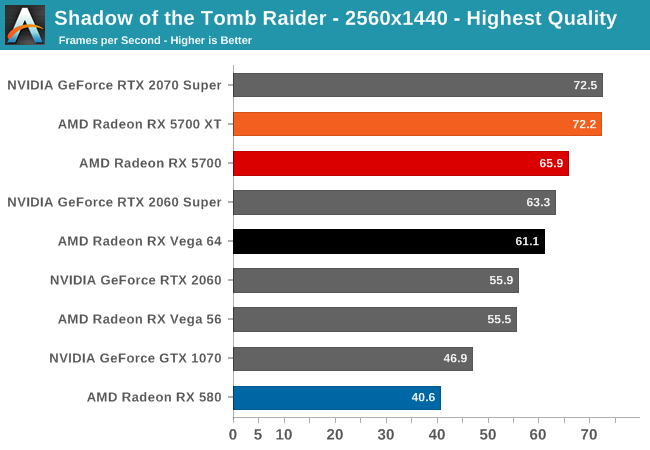
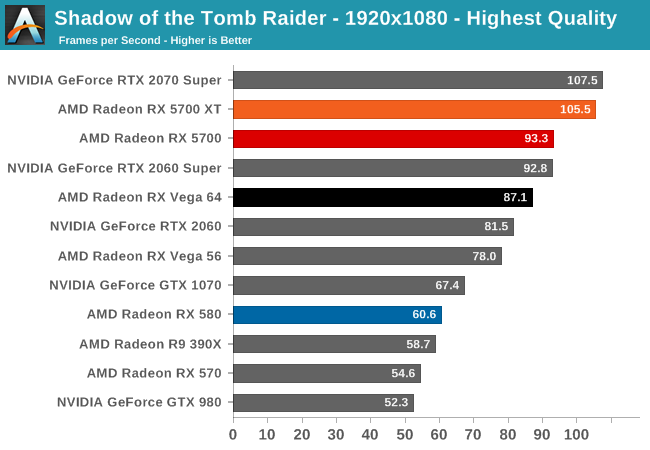
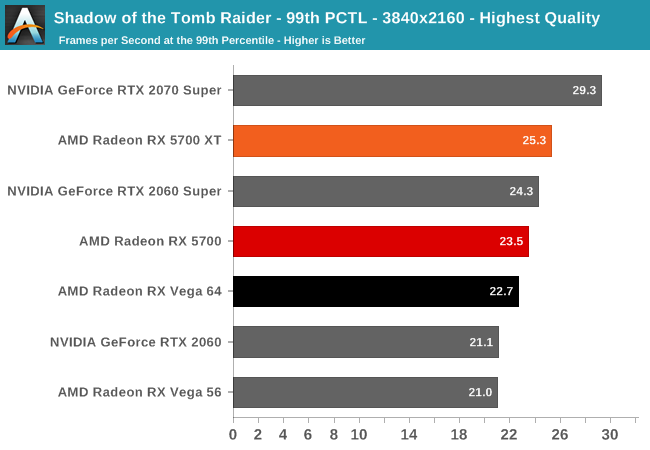
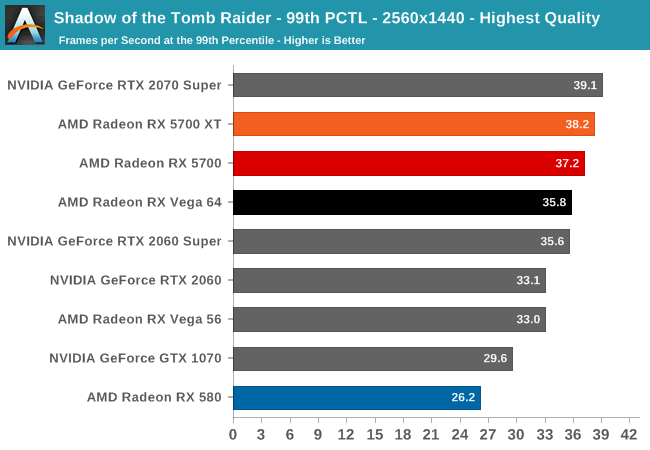
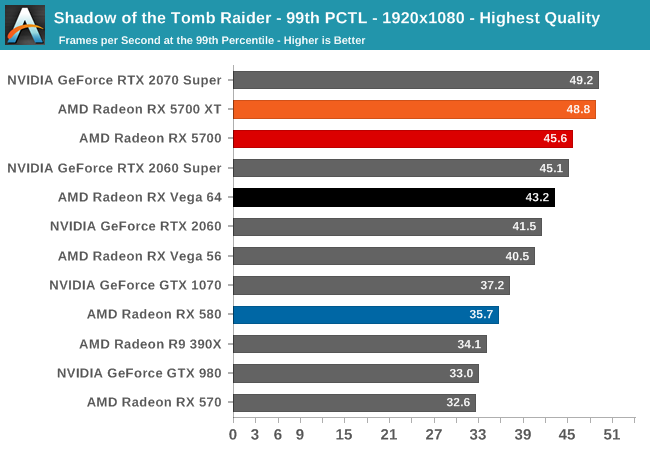
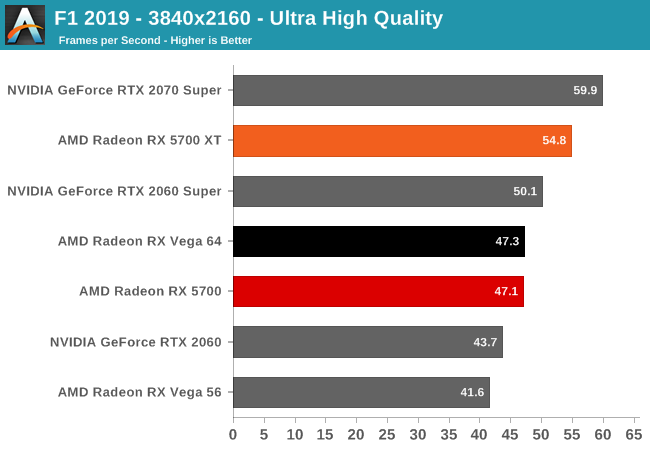
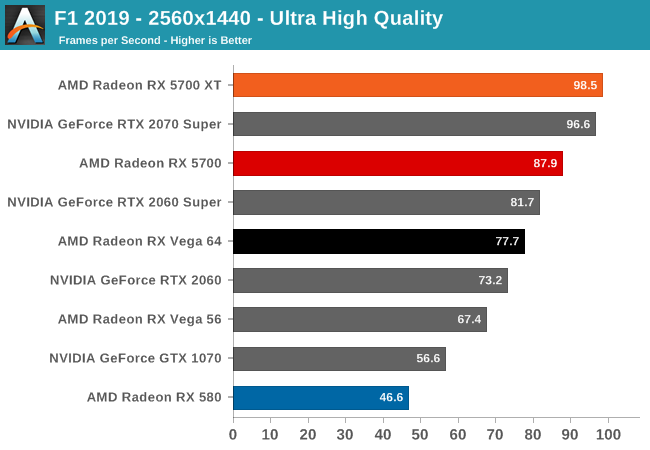


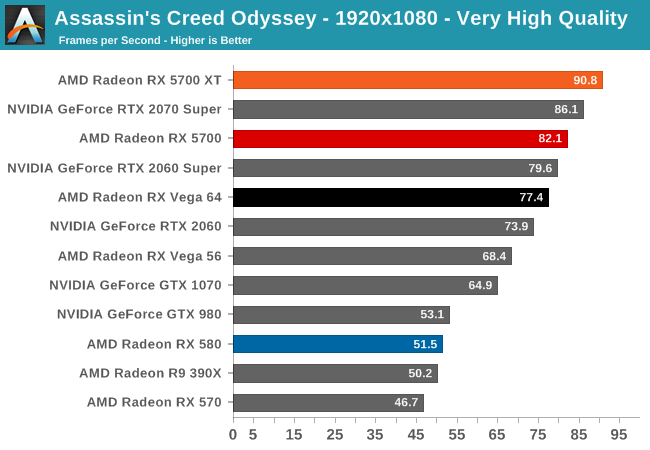

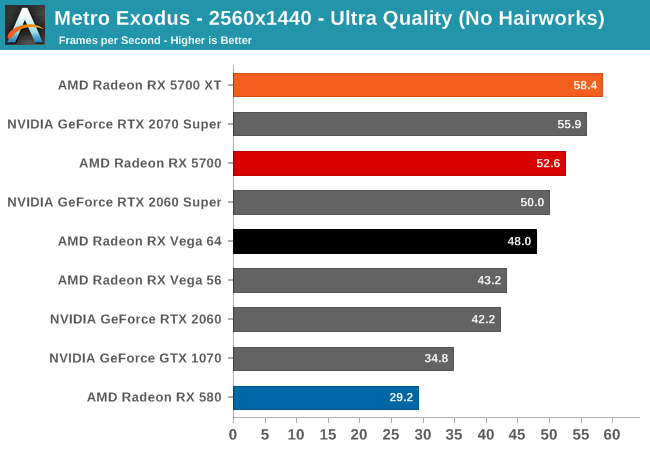

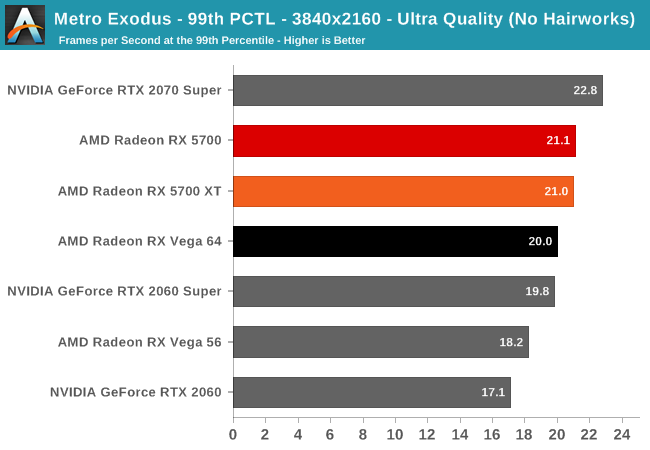
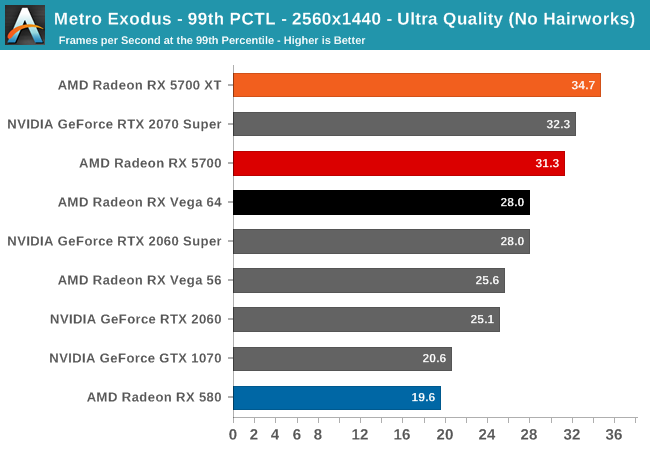
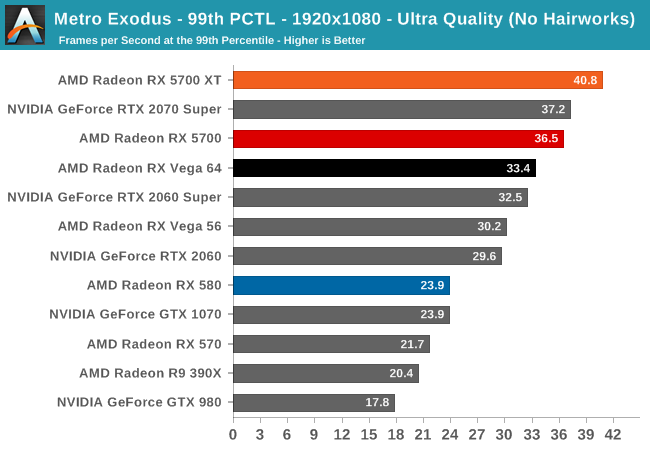
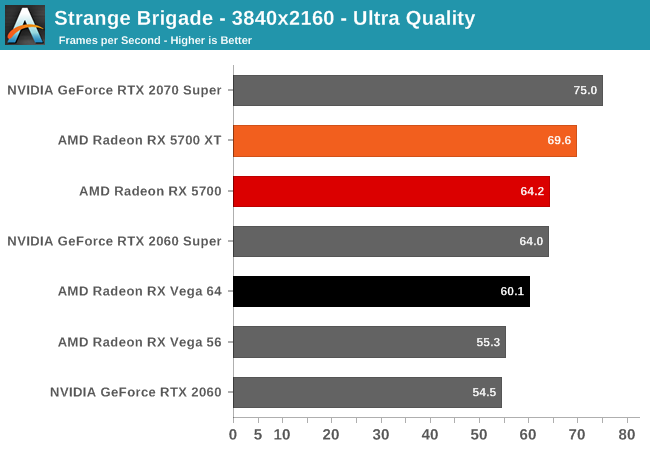
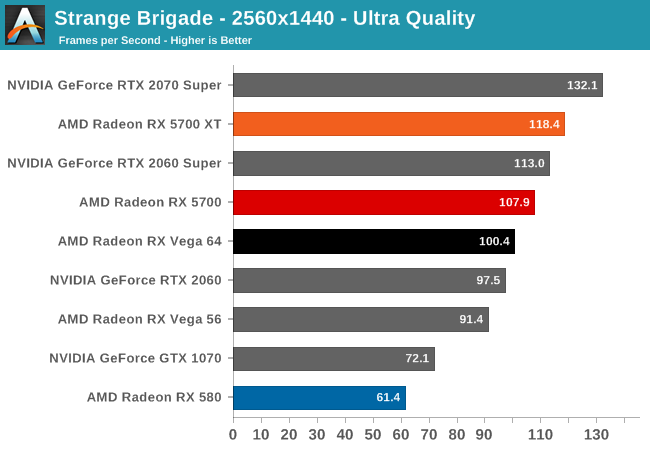
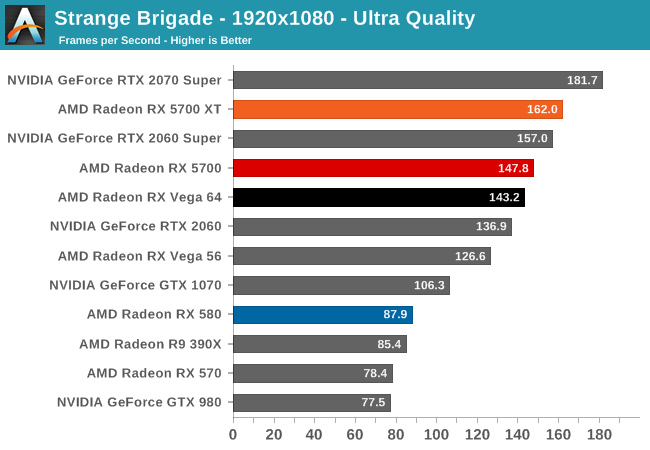
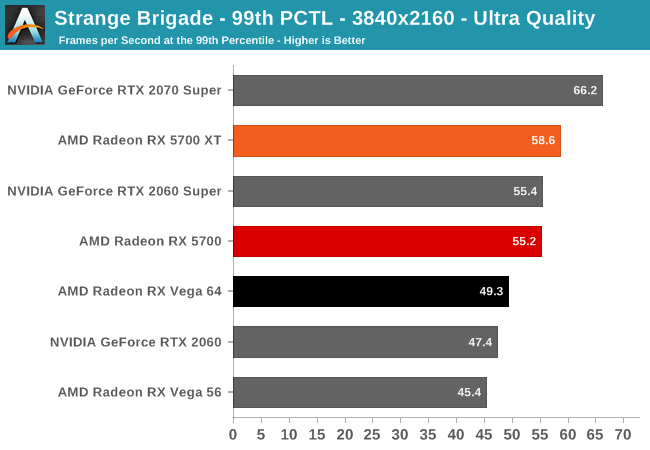
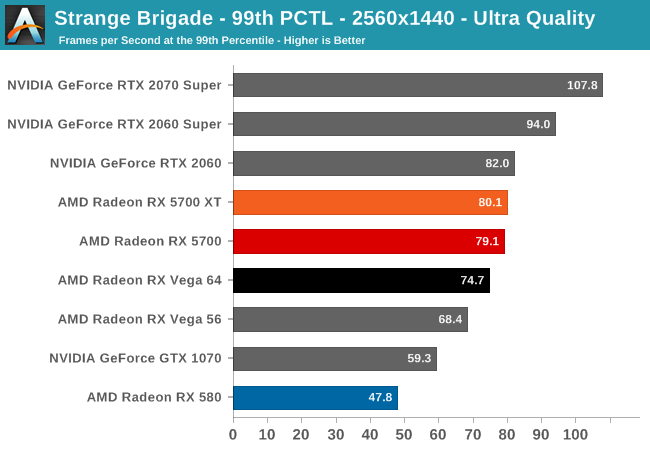

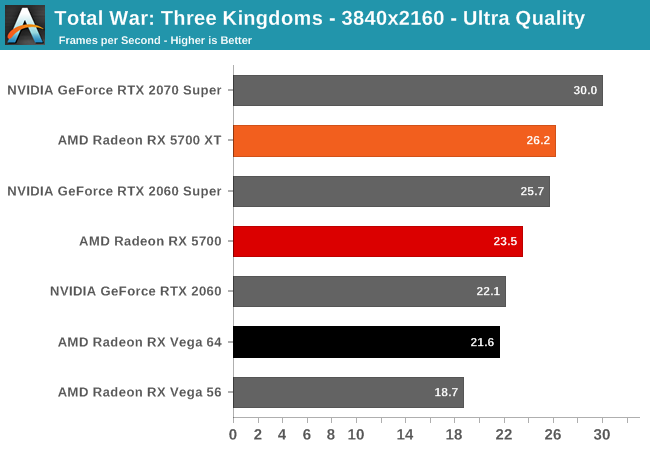

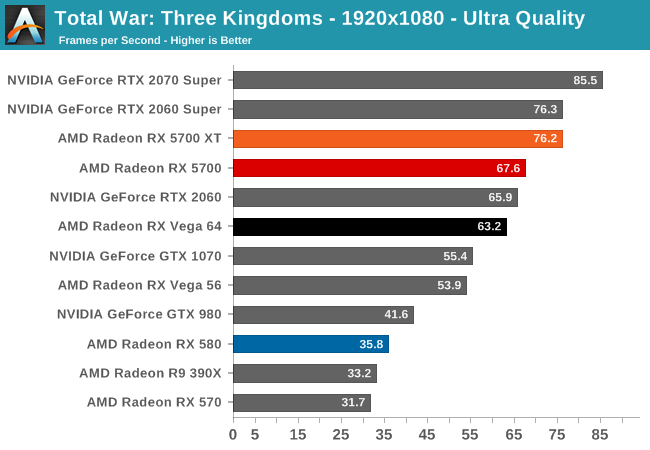
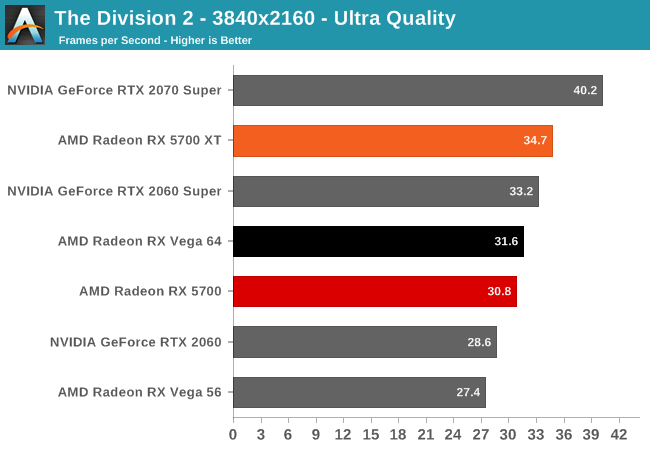

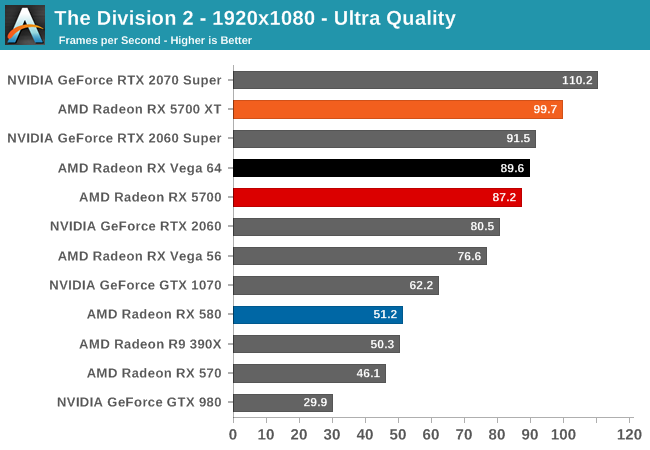
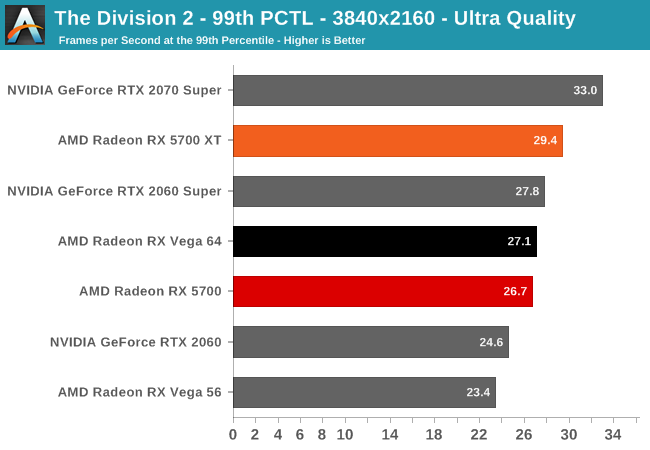
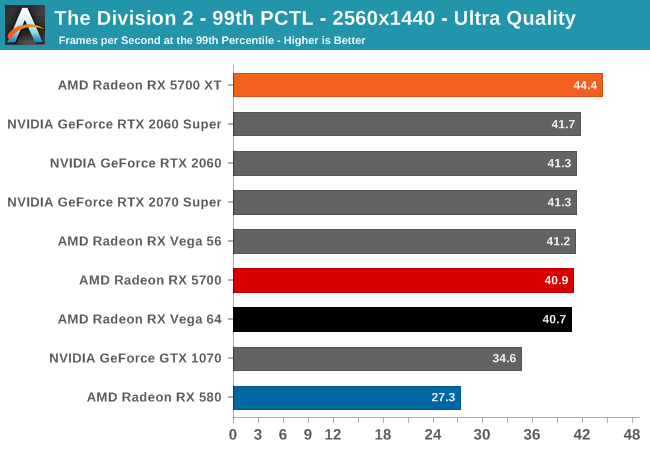
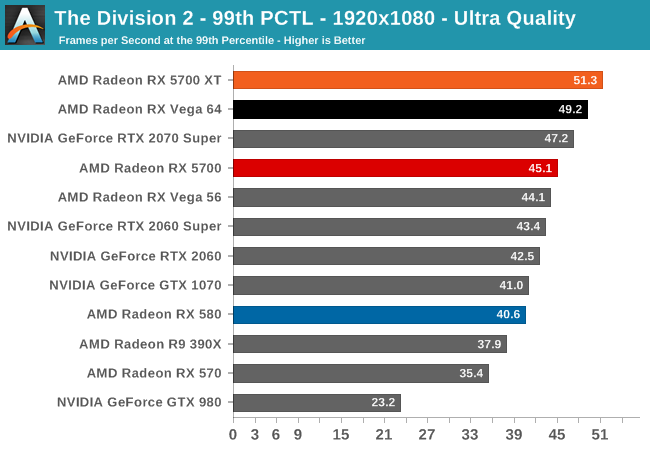
Now a truly venerable title, GTA V is a veteran of past game suites that is still graphically demanding as they come. As an older DX11 title, it provides a glimpse into the graphically intensive games of yesteryear that don't incorporate the latest features. Originally released for consoles in 2013, the PC port came with a slew of graphical enhancements and options. Just as importantly, GTA V includes a rather intensive and informative built-in benchmark, somewhat uncommon in open-world games.
The settings are identical to its previous appearances, which are custom as GTA V does not have presets. To recap, a "Very High" quality is used, where all primary graphics settings turned up to their highest setting, except grass, which is at its own very high setting. Meanwhile 4x MSAA is enabled for direct views and reflections. This setting also involves turning on some of the advanced rendering features - the game's long shadows, high resolution shadows, and high definition flight streaming - but not increasing the view distance any further.
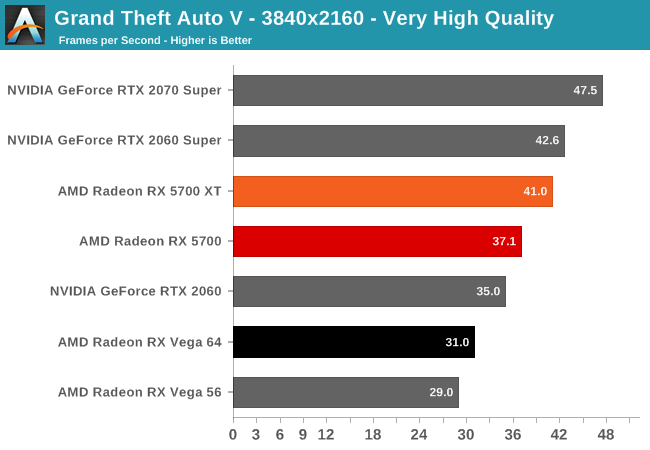
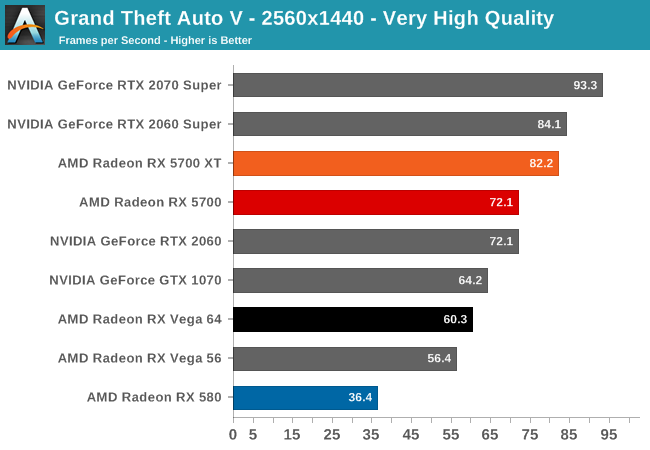
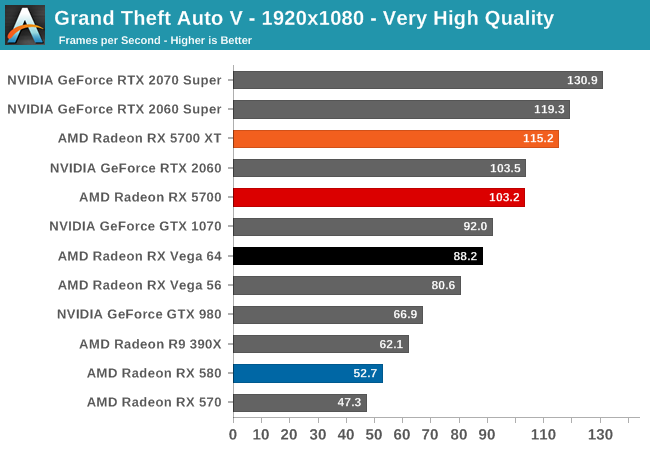

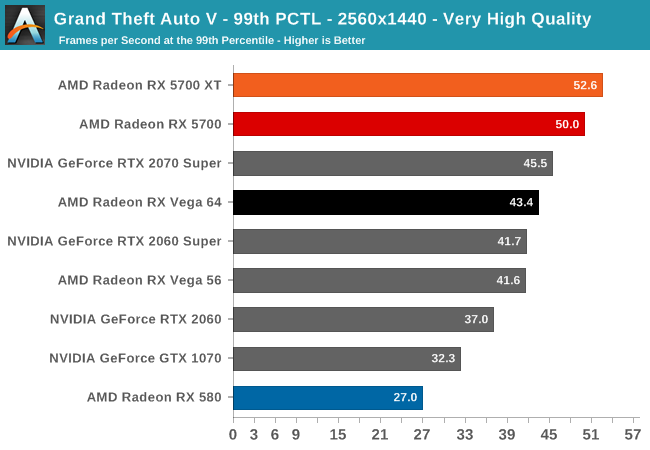
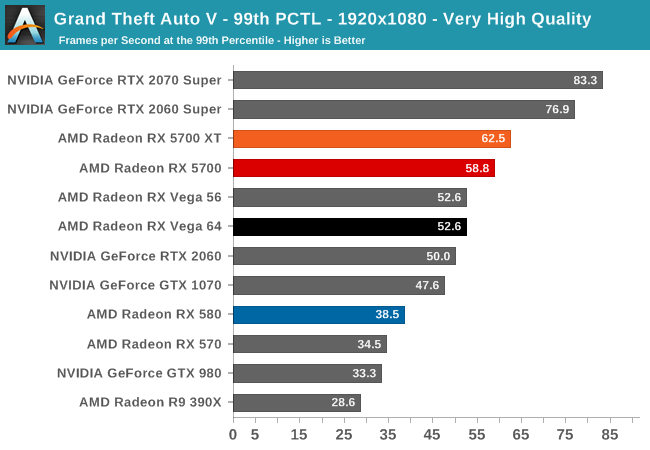
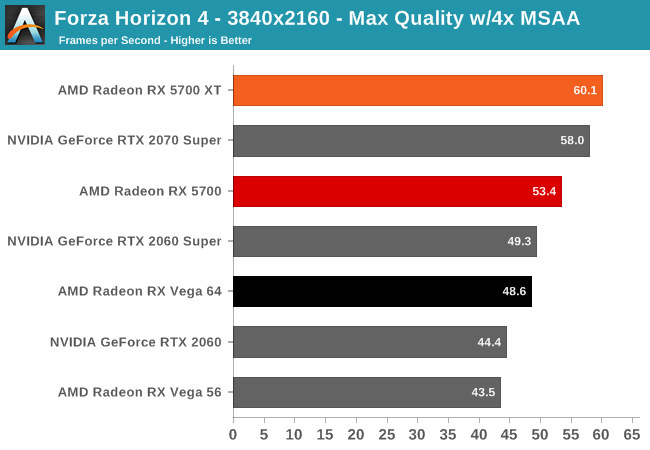
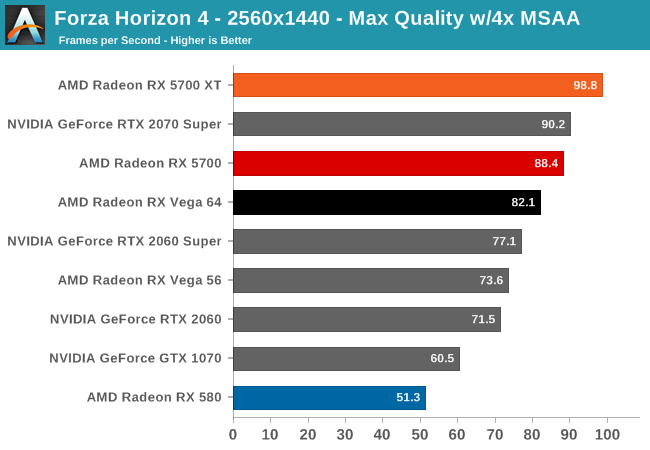

Unfortunately, as I mentioned earlier in my testing observations, the state of AMD's OpenCL driver stack at launch is quite poor. Most of our compute benchmarks either failed to have their OpenCL kernels compile, triggered a Windows Timeout Detection and Recovery (TDR), or would just crash. As a result, only three of our regular benchmarks were executable here, with Folding@Home, parts of CompuBench, and Blender all getting whammied.
And "executable" is the choice word here, because even though benchmarks like LuxMark would run, the scores the RX 5700 cards generated were nary better than the Radeon RX 580. This a part that they can easily beat on raw FLOPs, let alone efficiency. So even when it runs, the state of AMD's OpenCL drivers is at a point where these drivers are likely not indicative of anything about Navi or the RDNA architecture; only that AMD has a lot of work left to go with their compiler.
That said, it also serves to highlight the current state of OpenCL overall. In short, OpenCL doesn't have any good champions right now. Creator Apple is now well entrenched in its own proprietary Metal ecosystem, NVIDIA favors CUDA for obvious reasons, and even AMD's GPU compute efforts are more focused on the Linux-exclusive ROCm platform, since this is what drives their Radeon Instinct sales. As a result, the overall state of GPU computing on the Windows desktop is in a precarious place, and at this rate I wouldn't be entirely surprised if future development is centered around compute shaders instead.
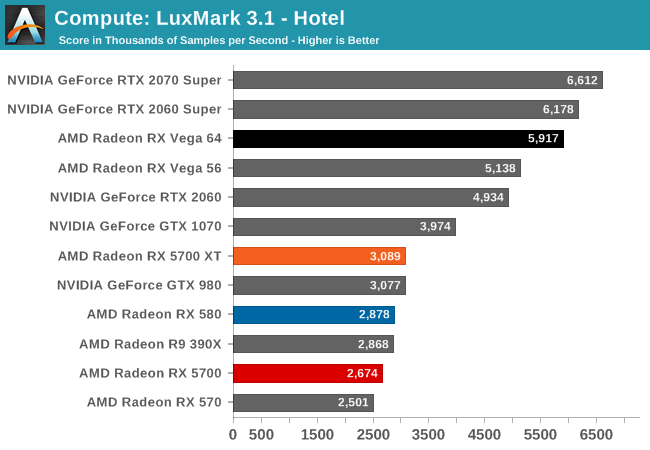
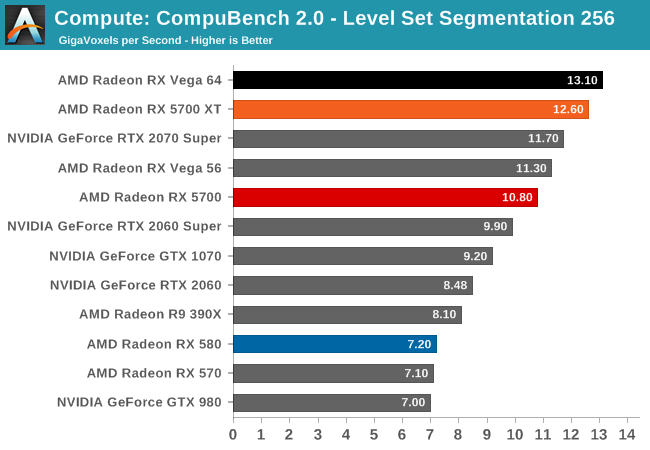
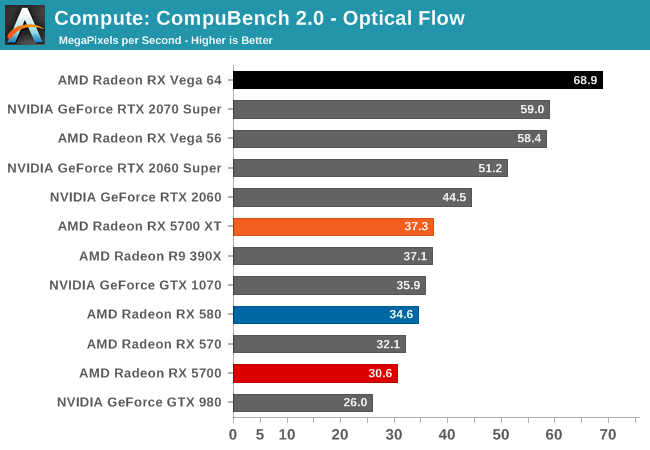
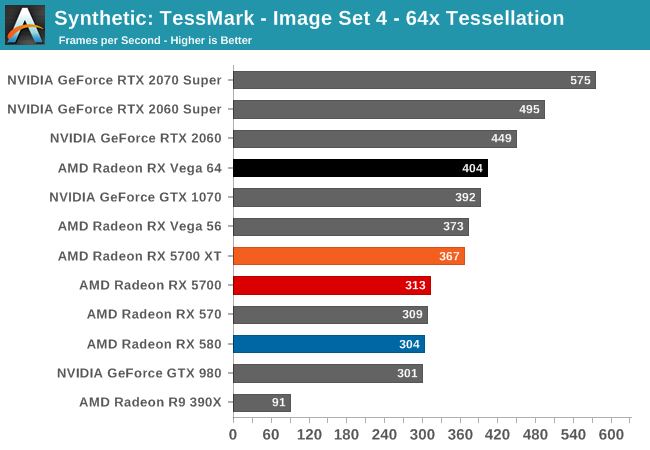
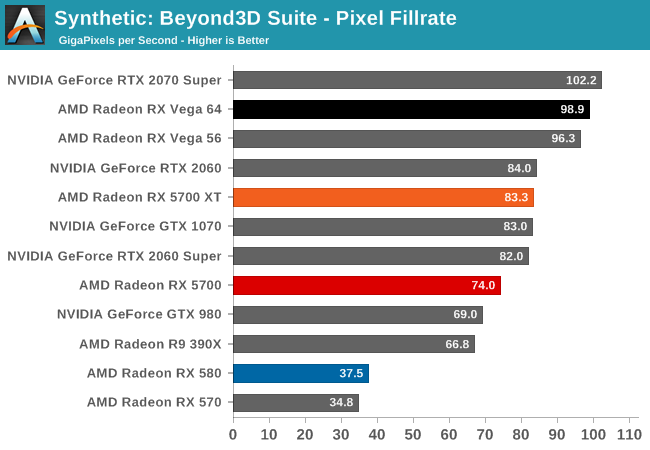

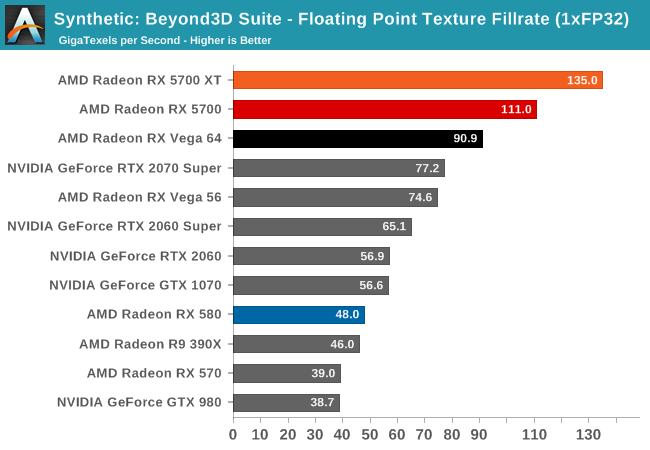
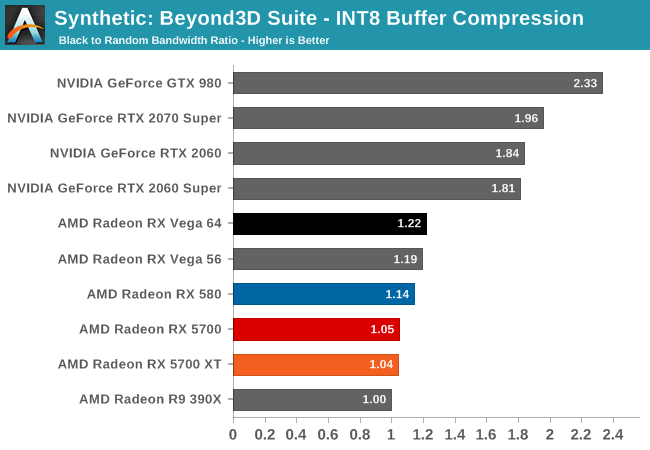
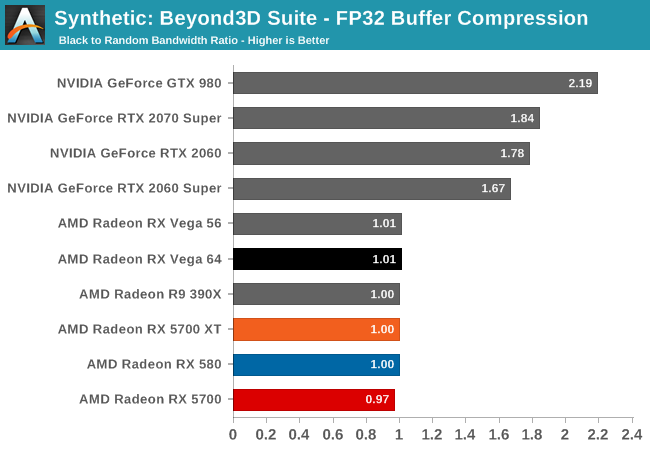
Last, but not least of course, is our look at power, temperatures, and noise levels. While a high performing card is good in its own right, an excellent card can deliver great performance while also keeping power consumption and the resulting noise levels in check.
| Radeon Video Card Voltages | |||||
| 5700 XT Max | 5700 Max | 5700 XT Idle | 5700 Idle | ||
| 1.2v | 1.025v | 0.725v | 0.775v | ||
Looking at boost voltages for AMD's new midrange 7nm cards, we don't have too many points of comparison right now. But still, with AMD's drivers reporting a maximum boost voltage of 1.2v for the 5700 XT, not even the incredibly juiced Polaris 30-based Radeon RX 590 took quite so much voltage. It may very well be that TSMC's high-performance 7nm process simply requires a lot of voltage here, but it may also be a sign that AMD is riding the voltage/frequency curve pretty hard to get those high clockspeeds.
By contrast, the 5700 (vanilla) is a much more mundane card. With its lower clockspeeds, the card never goes above 1.025v according to AMD's drivers. Which given the impact of voltage on power consumption, it's actually a bit surprising the spread is so large.
| Radeon Video Card Average Clockspeeds (Rounded to the Nearest 10MHz) |
|||
| Game | 5700 XT | 5700 | |
| Max Boost Clock | 2044MHz | 1750MHz | |
| Official Game Clock | 1755MHz | 1625MHz | |
| Tomb Raider | 1780MHz | 1680MHz | |
| F1 2019 | 1800MHz | 1650MHz | |
| Assassin's Creed | 1900MHz | 1700MHz | |
| Metro Exodus | 1780MHz | 1640MHz | |
| Strange Brigade | 1780MHz | 1660MHz | |
| Total War: TK | 1830MHz | 1690MHz | |
| The Division 2 | 1760MHz | 1630MHz | |
| Grand Theft Auto V | 1910MHz | 1690MHz | |
| Forza Horizon 4 | 1870MHz | 1700MHz | |
Meanwhile clockspeeds are also an interesting story. AMD said that they would no longer be holding back their chips' top boost clocks, and instead let the silicon lottery run its course, allowing the best chips to reach their highest clockspeeds. The end result is that our 5700 XT is allowed to clock up to 2044 MHz, 139MHz better than AMD's official Boost Clock metric guarantees. More to the point, this is a substaintial jump in frequency over both AMD's RX Vega and RX 500 series cards, which would top out around the mid-1500s.
That said, the 5700 XT doesn't have the TDP or thermal cap to susntain this; I couldn't actually hit 2044MHz even in LuxMark, which as a "light" compute workload tends to bring out the highest clockspeeds in processors. Instead, the best clockspeed I was able to hit was a bit lower, at 2008MHz. So while the silicon is willing, the physics of powering a Navi 10 at such high clockspeeds are another matter.
At any rate, even with TDP and cooling keeping the 5700 XT more down to earth, the card is still able to hit high clockspeeds. More than half of the games in our benchmark suite average clockspeeds of 1800MHz or better, and a few get to 1900MHz. Even The Division 2, which appears to be the single most punishing game in this year's suite in terms of clockspeeds, holds the line at 1760MHz, right above AMD's official game clock.
As for the 5700, with its more conservative TDP, clockspeed specifications, and likely some binning, the card doesn't reach quite as high. Its 1750MHz max boost clock is just 25MHz over AMD's guaranteed clock. Meanwhile its clockspeeds are overall a bit more densely packed than the 5700 XT's; all of our games see average clockspeeds between 1630MHz and 1700MHz.
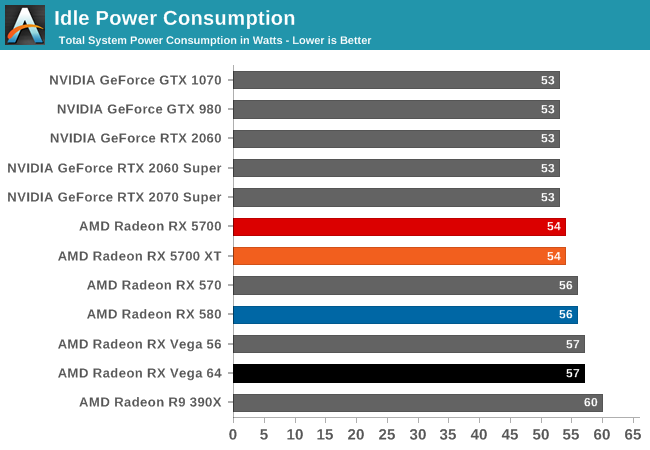
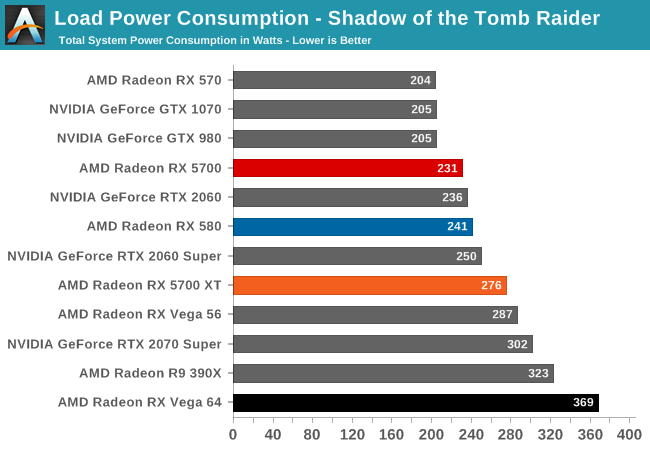
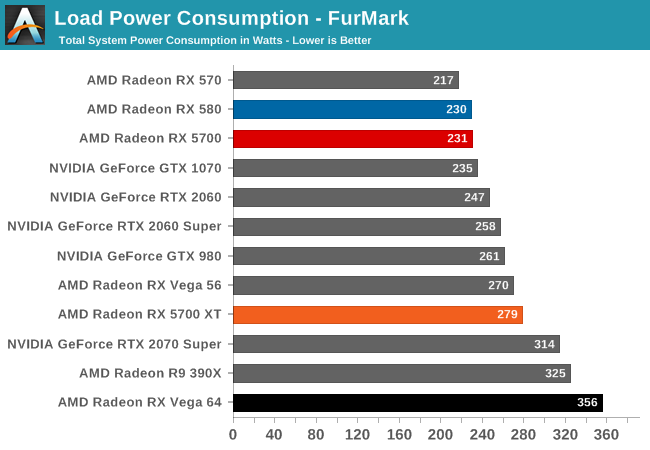


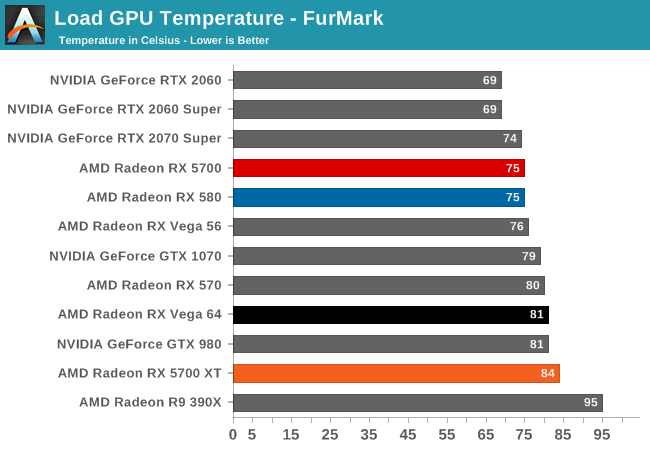
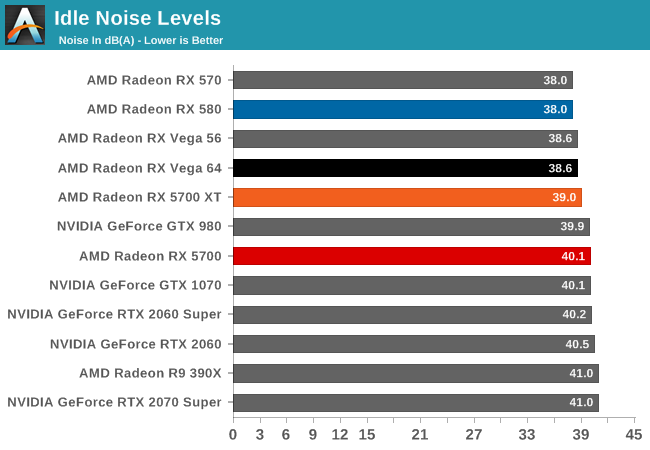
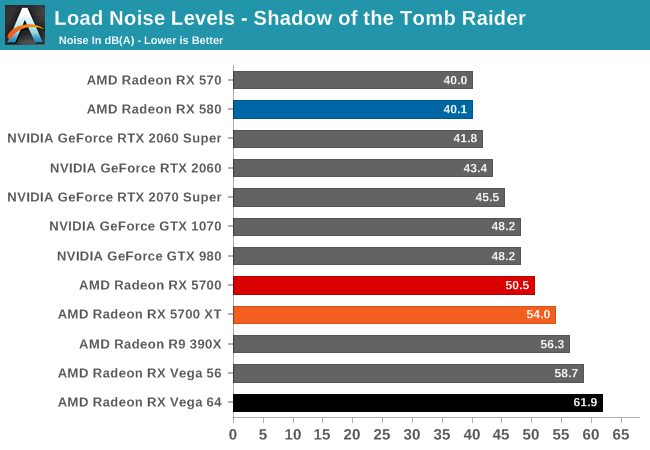
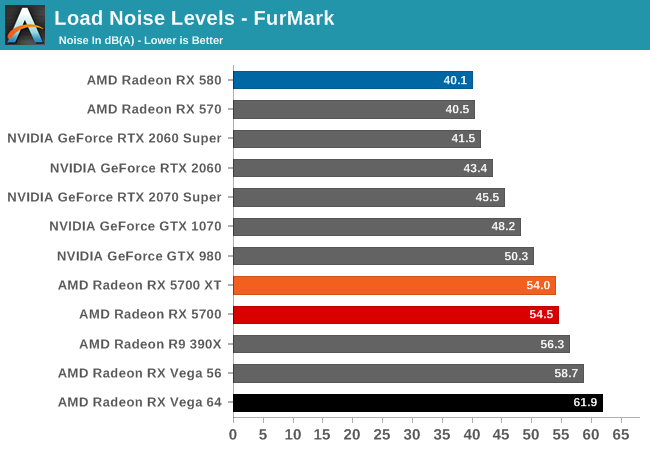
Easily the most exciting kind of video card launch, the dawn of a new GPU architecture is a rare event that’s not to be missed. New architectures give vendors a chance to turn the playing field on its metaphorical head, defying some expectations, setting new ones, and redefining what is possible with a video card. Especially in the case of today’s launch of the Radeon RX 5700 series cards, and their RDNA architecture Navi GPUs, there’s a lot to unpack. But one way or another, this is easily going to be the most important and eventful video card launch of 2019. So let’s dig in.
For those of you who are reading this rare Sunday launch article with a cup of coffee (or are an AnandTech editor who’s been drinking it all night long), perhaps it’s best to cut to the chase and then build out from there. RDNA is an incredibly important architecture for AMD, and it sets the stage for a lot of things to come. At the same time, however, it’s also the first part in a longer-term plan for AMD, with AMD continuing to further iterate on their design over the coming years.
So how does AMD’s first example of RDNA stack up? For AMD and for consumers it’s much needed progress. To be sure, the Radeon RX 5700 series cards are not going to be Turing killers. But they are competitive in price, performance, and power consumption – the all-important trifecta that AMD has trailed NVIDIA at for too many years now.
By the numbers then, the Radeon RX 5700 XT holds an 11% performance advantage over its nearest competition, NVIDIA’s new GeForce RTX 2060 Super. Similarly, the RX 5700 (vanilla) takes a 12% advantage over the RTX 2060 (vanilla). So NVIDIA was right to shift their product stack last week in preparation for today’s AMD launch, as AMD is now delivering the performance of what was last week a $500 video card for as little as $350. That’s a major improvement in performance-per-dollar, to say the least.
| Performance Summary | |||||
| Price | Relative Performance | Relative Perf-Per-Dollar |
|||
| RX 5700 XT vs RTX 2060 Super | $399 | +11% | +11% | ||
| RX 5700 vs. RTX 2060 | $349 | +12% | +12% | ||
| RX 5700 XT vs RTX 2070 Super | $399/$499 | -5% | +19% | ||
And, thankfully, none of this breaks the bank on power consumption either. The RX 5700 fares slightly better than its opponent, while the highly-clocked RX 5700 XT is more power-hungry in securing its performance advantage over the RTX 2060 Super. Which, with the RX 5700 within spitting distance of the RTX 2070 Super in terms of gaming performance, it gives you a good idea of what the power cost was for that last 11%. For the moment then, while AMD hasn’t significantly shifted the power/performance curve versus Turing, they also have avoided the same kind of painful performance chase that delivered toasty cards like the RX Vega 64 and RX 590.
If there is a real downside here, it’s that AMD’s blower-based coolers aren’t going to impress anyone with their performance, even by blower standards. The RX 5700 XT is a bit louder than even NVIDIA’s GTX 1080 Ti, which is a flat-out higher TDP card. To be sure, it’s well ahead of the RX Vega series here (or even the reference 390X I dug out), but AMD has yet to completely master the dark art of quiet blowers.
Tangentially, the biggest risk for AMD here is that they’ve achieved a lot of this efficiency gain by leaping ahead of NVIDIA by a generation on the manufacturing side, tapping TSMC’s 7nm process. NVIDIA will get their own chance to tap into the benefits of the new node as well, which all other elements held equal, is likely to tilt things in NVIDIA’s benefit once again. The fortunate thing for AMD, at least, is that NVIDIA doesn’t seem to be in a hurry to get there, and we’re not expecting 7nm NVIDIA consumer parts this year.
The outstanding question for gamers then is whether AMD’s performance and value advantage is enough to offset their feature deficit. With AMD’s efforts fully invested into the backend of their RDNA architecture as opposed to adding user-facing features, the RX 5700 series doesn’t bring any marquee hardware features to the table, and it doesn’t do anything to catch up to NVIDIA’s RTX cards. The end result is that the Radeon cards are faster for the price, but NVIDIA brings things like ray tracing and variable rate shading that AMD cannot.
Truthfully, there is no good answer here – at least not one that will be universally agreed upon. Variable rate shading is merely a (cool) performance optimization, but hardware accelerated ray tracing is something more. And NVIDIA has been working very, very hard to get developers to adopt it. The current crop of games arguably isn’t using it to earth-shattering effect (though Metro is coming close), but the slate for 2020 includes several high-profile games. So it comes down to a question of whether to take the higher performance now and risk the fear of missing out later, or taking ray tracing now for an unproven future?
Ultimately, I don’t think there’s a bad buy here between the RX 5700 XT and the RTX 2060 Super it competes with; both are solid cards with some unique pros and cons, and either one should make most gamers happy. As for the vanilla showdown between the RX 5700 and RTX 2060, AMD’s hand is much stronger here (or rather, NVIDIA’s is weaker), which makes for an easy decision. The RX 5700 is faster, slightly less power hungry, and it features a full 8GB of VRAM. The RTX 2060 was always a risky buy with its mere 6GB of VRAM, and now with the RX 5700 there’s really no reason good enough to consider it, even with ray tracing.
As for gamers looking for an upgrade, things are a bit more mixed. The entrance of the RX 5700 series has pushed midrange video card prices down, but not by incredible amounts. On a pure performance basis, AMD’s new cards would be very solid upgrades over the RX 500 series in terms of performance and with similar energy usage, but then they also cost nearly twice as much as the RX 500 series did at launch. The RX 5700 series is perhaps best described as a replacement for the RX Vega series and a successor to the RX 500 series; however it is not a successor to RX Vega, nor is it a proper replacement for RX 500. Instead, the new cards are a more meaningful upgrade for any GTX 970 or R9 390(X) holders who are looking for their next midrange card. In which case the RX 5700 series delivers more performance in leaps and bounds.
In the meantime, it’s a welcome sight to see a more competitive AMD in the video card market. With AMD not-so-concentrically launching a new range of excellent CPUs today, a new cycle of system builds is kicking off, which the RX 5700 series is well-positioned to capture a piece of. Ultimately then, while the Radeon RX 5700 series is not AMD’s Ryzen 3000 moment for video cards, it’s a return to form for the company and it’s great to see competition renewed within the video card space. Now to see where the rest of AMD’s journey with Navi takes them over the coming months.
https://www.anandtech.com/show/14618/the-amd-radeon-rx-5700-xt-rx-5700-review
2019-07-07 17:00:00Z
52780327749348
Bagikan Berita Ini


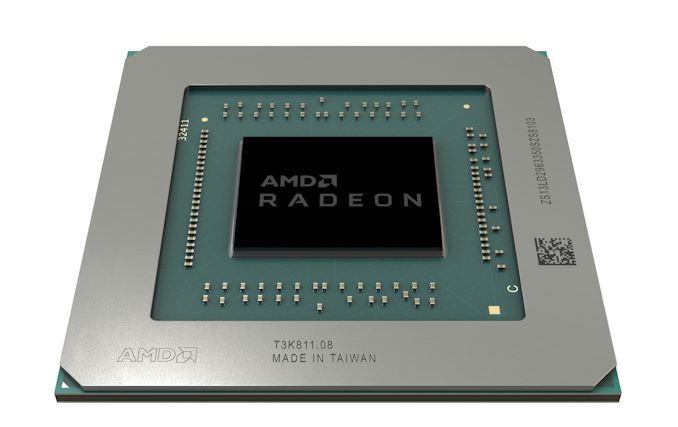

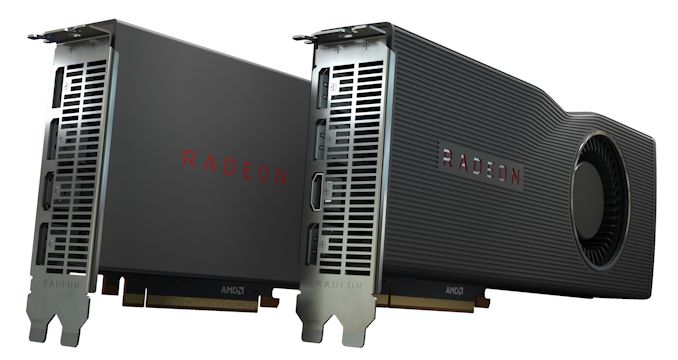
















0 Response to "The AMD Radeon RX 5700 XT & RX 5700 Review: Navi Renews Competition in the Midrange Market - AnandTech"
Post a Comment